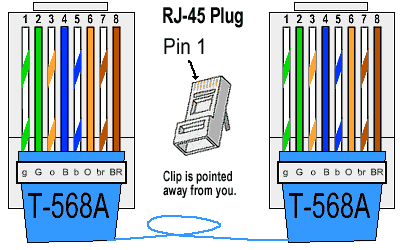Running Ethernet: Difference between revisions
| Line 17: | Line 17: | ||
===Ethernet Cable=== | ===Ethernet Cable=== | ||
These days, you should be using Cat6 | These days, you should be using Cat6 or better. | ||
Cat6 is suitable for Gigabit runs up to 100 meters and 10 Gigabit up to 55 meters. | Cat6 is suitable for Gigabit runs up to 100 meters and 10 Gigabit up to 55 meters. | ||
Cat5e can do Gigabit and 2.5G over shorter distances. | |||
* Avoid CCA (Copper clad aluminum) cables;. They're allegedly less reliable and less resilient to bending. | |||
* Shielded cables are unnecessary for most installs. Apparently, you only need them if you plan to run them along power lines. | |||
* Avoid CCA (Copper clad aluminum) cables;. They're less reliable and less resilient to bending. | |||
* Shielded cables are unnecessary for most installs. | |||
* I've had luck with [https://www.ebay.com/itm/401679433529 premiertek_official's 1000 ft Pure Copper Outdoor Cat6] on eBay. | * I've had luck with [https://www.ebay.com/itm/401679433529 premiertek_official's 1000 ft Pure Copper Outdoor Cat6] on eBay. | ||
Revision as of 20:25, 2 July 2021
Running Ethernet throughout your house.
Materials
As a bare minimum you'll need the following:
- Ethernet Cable.
- RJ45 Plugs. 100 pack
For more professional installs, you'll also want to have:
- Cat6a Ethernet Cable for long 10 Gigabit runs.
- Keystones Wall Plates Mounting Brackets
For outdoor runs, you'll need the following:
- Cable clips
- Or nails if you'd rather use a nail gun.
- Duct Seal for filling holes.
Ethernet Cable
These days, you should be using Cat6 or better.
Cat6 is suitable for Gigabit runs up to 100 meters and 10 Gigabit up to 55 meters.
Cat5e can do Gigabit and 2.5G over shorter distances.
- Avoid CCA (Copper clad aluminum) cables;. They're allegedly less reliable and less resilient to bending.
- Shielded cables are unnecessary for most installs. Apparently, you only need them if you plan to run them along power lines.
- I've had luck with premiertek_official's 1000 ft Pure Copper Outdoor Cat6 on eBay.
Tools
For basic runs, you'll only need the following:
If you are using keystones, you may want an Punch Down Tool.
For outdoor runs, get the following:
- A drill for outdoor runs and relevant bits. You will need a long drill bit (12 in) to drill through walls. Normal bits are sufficient for drilling through studs.
- Notes
- There are some cheap kits on amazon which include multiple items (e.g. crimper, wire stripper, tester, plugs). I cannot comment on the quality of them.
- The basic cable tester only ensures continuity. You should do a quick iperf3 test to make sure you're getting the speeds you expect.
Terminating Ethernet Cables


Terminating an ethernet cable is fairly straight forward:
- Strip the end of the cable approx 1 inch.
- Cut off the rip-cord and plastic separator.
- Line up the stands and trim them to equal length.
- Stick them inside the Rj45 jack and crimp.
- Notes
- Hold the cable still as you trim the strands and crimp. Otherwise their length will change.
There are two standards for terminating ethernet cables: T568A and T568B.
T568B is the newer standard and the one I use.
It doesn't matter which standard you use as long as it is consistent on both ends of the cable.
Resources
Note that these videos are several years old so they use Cat5e but the same ideas apply for Cat6.
- LTT Running Outdoor Ethernet
- For entertainment and showing how to hide runs.
- How to Crimp Ethernet by AAFTech
